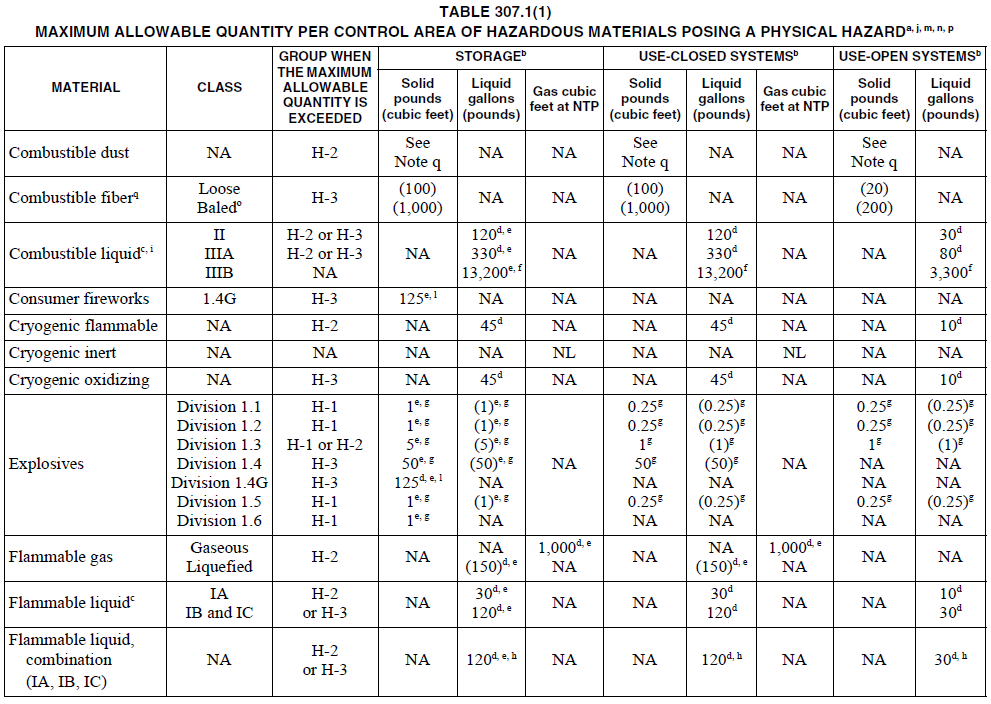Is My Facility A High-Hazard H-2 or H-3 Occupancy? 2017-07-13
By James T. Farrell, AIA, PMP, LEED APIf you are designing, building or operating a manufacturing facility in the United States, you will need to comply with the International Building Code. One of the questions we answer most often is, ‘Is my facility an High-Hazard H-2 or H-3 Occupancy?’. Chapter 3 – Use and Occupancy Classification of the International Building Code classifies each building type into an occupancy group based on the use of the building. High-Hazard Occupancies are buildings or portions of buildings that exceed the maximum allowable quantity of hazardous materials identified in Table 307.1 of the International Building Code (Link to Chapter 3 of the IBC)
 © 2014 International Code Council, Inc.
© 2014 International Code Council, Inc.
Once you exceed the maximum allowable quantity (including any allowed increases) your occupancy group is elevated to an High-Hazard H-2 or H-3 Occupancy. In the Flavor and Fragrance and Cosmetic Industries, we typically see the allowable quantities of Flammable and Combustible Liquids above the maximum allowable quantities. Table 307.1 lets you quickly determine if you exceed the exempt amount based on the condition of the hazardous materials in question. Hazardous materials can be kept in one of three options: storage, use-closed systems or use-open systems. Here are the definitions for each category:
STORAGE, HAZARDOUS MATERIALS. The keeping, retention or leaving of hazardous materials in closed containers, tanks, cylinders, or similar vessels; or vessels supplying operations through closed connections to the vessel.
CLOSED SYSTEM. The use of a solid or liquid hazardous material involving a closed vessel or system that remains closed during normal operations where vapors emitted by the product are not liberated outside of the vessel or system and the product is not exposed to the atmosphere during normal operations; and all uses of compressed gases. Examples of closed systems for solids and liquids include product conveyed through a piping system into a closed vessel, system or piece of equipment.
OPEN SYSTEM. The use of a solid or liquid hazardous material involving a vessel or system that is continuously open to the atmosphere during normal operations and where vapors are liberated, or the product is exposed to the atmosphere during normal operations. Examples of open systems for solids and liquids include dispensing from or into open beakers or containers, dip tank and plating tank operations.
Now that you have determined which system your facility is using, you can determine if you exceed the exempt amount. It is important to understand that the quantities shown in Table 307.1 above can be increased based on several modifiers. Contact me at jfarrell@fp.design if you have questions about allowed increases. If your process exceeds the maximum allowed quantity, your facility is classified as an High-Hazard H-2 or H-3 Occupancy.
So – Is it an H-2 or H-3 Occupancy? What is the difference between High-Hazard H-2 or H-3 Occupancy, and why does the building code allow you to choose between them? High-Hazard H-2 occupancy is more stringent than High-Hazard H-3 occupancy and requires additional physical controls than H-3 occupancy. In general, for combustible and flammable liquids, if you employ an open process or if you utilize pressurized transfers at more than 1 bar (14.7 psi), your facility will be rated High-Hazard H-2 Occupancy.
Need help with code compliance and hazardous material assessment for your facility? Farrell Partnership is the industry leader in the design and construction of hazardous manufacturing facilities for the Flavor and Fragrance, Food and Cosmetic Industries. Contact us at +1 732-257-5700 or email us at: info@farrellpartnership.com for more information.